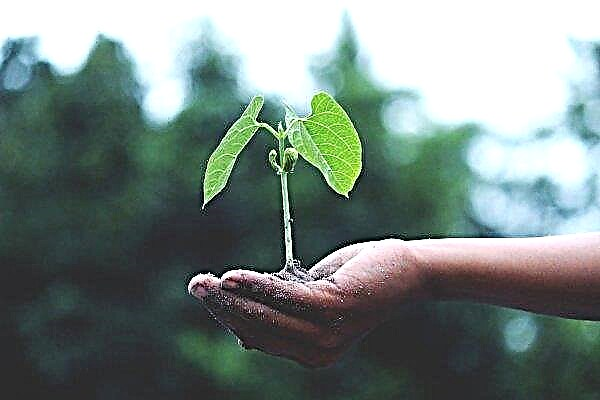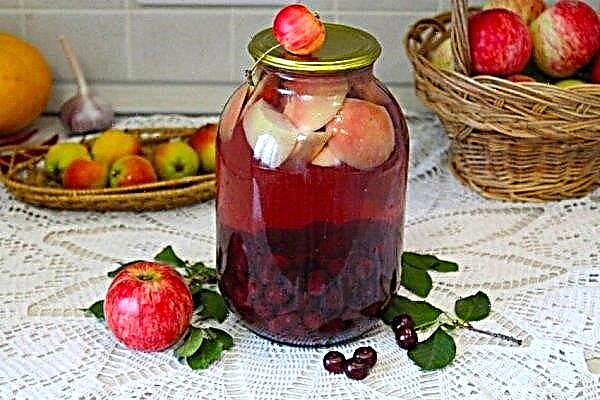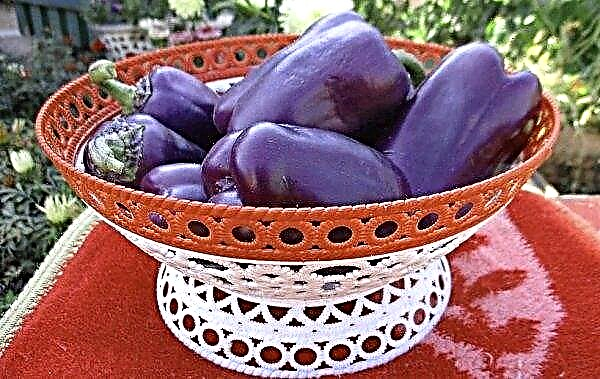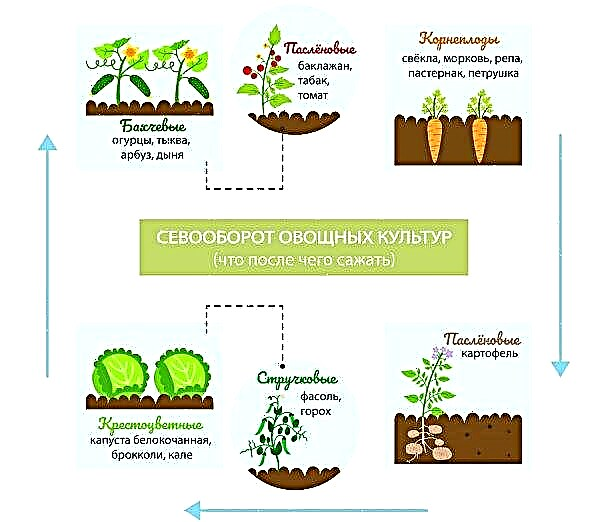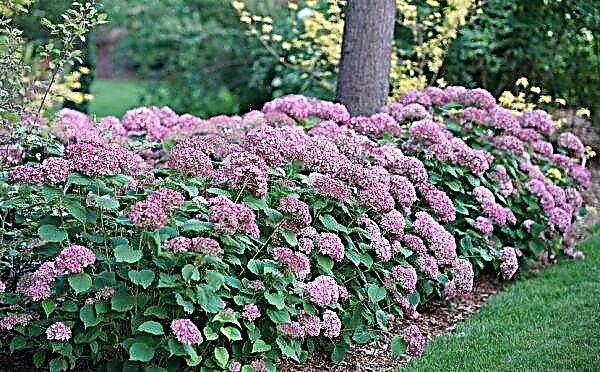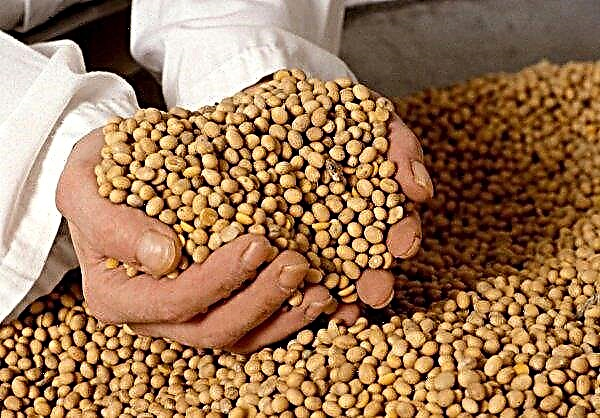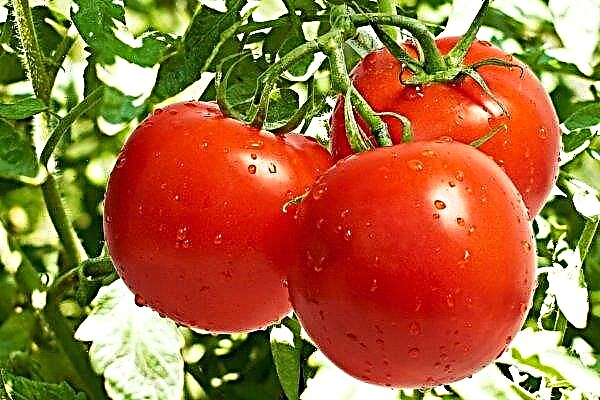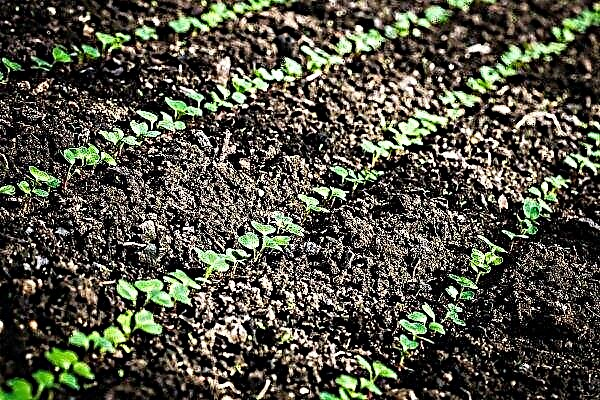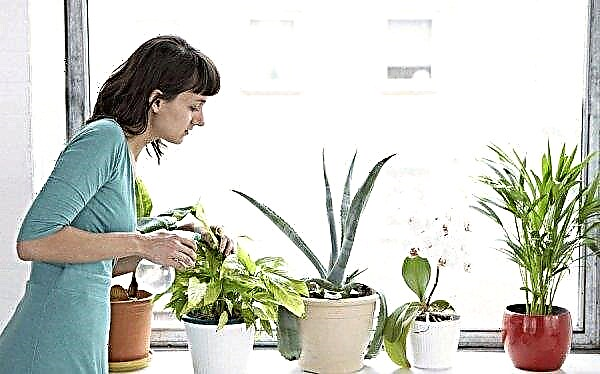The exquisite aroma of snow-white flowers, plentiful flowering and long emerald whips can decorate not only a large-scale winter garden or greenhouse, where, as it is believed, stefanotis develops faster. If you know about the intricacies of care and ensure the necessary conditions of detention, Madagascar jasmine, as it is also called, will reveal in all its glory to the joy of the happy owners of tropical exoticism.
Botanical Description
Despite the resemblance to the hoya, the long-standing shrub belongs to another subfamily of the Lastovnykh family of the Kutrovs and does not belong to succulents. For the first time, an exotic liana was found in the penumbra of the fringes of the forests of Madagascar and the Malay Islands and was described at the beginning of the 19th century. The length of an evergreen creeper in nature reaches 6 m, but at home, the lashes grow on average up to 2 m. Young elastic stems are elastic, prone to lignification with age. On short petioles, rigid dark green lacquer sheets of ellipsoidal shape with pointed ends are arranged in pairs.
Did you know? At night, jasmine smells stronger than during the day, because when the air temperature drops, the buds open completely..
The central vein at the fold of the glossy plate is pronounced. The width of the leaves is up to 5 cm, the length is 9 cm. With proper care they can reach the size of a human palm. If the stems and leaves are damaged, juice is released that irritates the skin and mucous membranes, so it is recommended to wear gloves for any manipulations with the plant.
The flower resembles a crown with inverted serrated petals. Five-petalled flowers of milky white color with cream and purple variations are collected by corymbose loose clusters. The corolla 5 cm in size has up to 7 buds, whose diameter is 2.5 cm. Wave-like flowering lasts in nature up to 10 months. In the room, it is limited to the period from May to October. In May and June, the largest number of flowers blooms with a delicate, sweet aroma. Another wave of budding is possible with due care from October to December.
After pollination and wilting of the flower, an oval, box-like, inedible fruit-berry is formed, when ripening, it produces small pubescent seeds, similar to the seed of dandelions, which the wind carries in a similar way. At home, pollination is possible without a partner, but the fetal ovary is rare. The root system is well developed and tightly braids the soil in the container.
Important! The intense smell of Madagascar jasmine is similar to a lily. Avoid placing the flower in the children's room and bedroom if there are signs of allergies or intolerances.
In a natural habitat, the decorative qualities of cultivated stephanotis of abundant flowering (Stephanotis floribunda) are used to create hedges, since the plant is prone to branching and gives a large amount of basal shoots. The flower is also popular in the cut: long flowers that do not fade, like stars, have become an integral part of bouquets for brides and an elegant decoration of a wedding dress.

What are the varieties of stefanotis
The plant is distinguished by the color of the flowers. A total of 16 species known to science are described that can be found in Cuba, Japan, South China, Indonesia, and South Africa, but only Stephanotis floribunda and its varieties of Floribunda variegata with striped and spotty leaves are cultivated from them. smoothed out at the end. These species, unlike the others, managed to adapt to room conditions after the heat and humidity of rainforests.
In addition to them, in nature are often found:
- Stephanotis Acuminata (Stephanotis Acuminata) with a creamy shade of flowers;
- Stephanotis Grandiflora (Stephanotis Grandiflora) with a characteristic dense inflorescence, consisting of 30 large flowers, and greenery at the thin base of the bud;
- Stephanotis Thouarsii (Stephanotis Thouarsii), whose purple flowers have a delicate pink pharynx.

Transfer
Adult flower, despite the growth rate, it is not recommended to transplant often. Do not do this immediately after buying a flowering specimen, if the plant looks viable, with a good visual assessment of the soil condition, even if the root system is visible at the drainage holes. It is optimal to place stephanotis every 2-3 years in fresh soil, young plants are replanted annually, for large bushes it is enough to change the top layer of the earth.
Important! When forming buds, it is better not to move the pot to avoid dropping them. Mark one side of the container to return the plant to the same position after any manipulations.
Basic rules and preparation
In cases where the purchased plant withers away, while the earth is caked, withered, flooded, acidified or contains salt deposits on the surface, the liana will require immediate transshipment. Its necessity is signaled by the roots that have exceeded the limits of the pot and the drying of the substrate too quickly. The best time for this is February and the following months before the start of the growing season.

For a painless transplant, prepare the necessary accessories in advance:
- ceramic pot, 2 cm larger than the root system, stable due to the large crown, with good openings for water drainage. In large pots, stefanotis does not bloom and grows worse until the roots completely conquer the earth. In a tight container, the liana develops well and produces a huge number of buds;
- drainage, consisting of vermiculite, small-fraction clay shards, expanded clay or gravel, the volume of which will take about 20% of the height of the landing tank, but not less than 3 cm;
- land substrate, bought or mixed independently, should consist of heavy soil with a slightly acid reaction (up to 6 pH). A sanitized mixture of 3 parts peat or humus, 2 parts of river sand, 1 part of deciduous land and the same clay-turf will do. Coarse sand can be replaced with vermiculite, and clay-turf soil with pine bark;
- seedling without buds, the desired height of which when planting does not reach 0.5 m. Such a plant will take root more quickly. If there are flowers, transplantation is not recommended. It should wait for flowering, and then change the soil;
- growth stimulants for the first watering and spraying.

Transplant process
In order for the transshipment process to go unnoticed by the plant, follow the step-by-step instructions:
- Free the roots of a storey seedling from a non-woven bag without damaging the soil lump.
- After filling the bottom of the pot with a drainage layer, fill 1/3 of the free space with the prepared soil mixture.
- Carefully transfer the liana to a new container, taking care not to damage the weak and brittle roots, designed to absorb moisture.
- Having established stefanotis, add in a circle the soil mixture.
- Pour abundantly and remove excess moisture from the pan. In the first watering, use a solution of root stimulants (for example, 0.5 g of “Kornevin” per 0.5 l of warm water) and a 0.5% solution of micronutrient “Iron Chelate”.
- Spray, evenly wetting the crown, with Epina-Extra solution (1 ampoule per 5 liters of water).
- Place the plant away from the direct rays of the sun, providing it with bright diffused light or illumination with a lamp.

Support
Due to their biological characteristics, long shoots of creepers need a strong support, which should be taken care of during planting. The purpose of such a structure is to support the stem, recreating the natural environment, where a liana braids any large object in the neighborhood. If you do not plan a transplant, you can install larger support during spring pruning. Even if some sprouts break, stefanotis will quickly restore shape and density.
Having cut off the excess length of the faded lashes, drape the remaining guide supports with the remaining ones, directing the young green branches in the desired direction. Fasten them with a soft twine, tying them in several places. Over time, lumbering trunks will hinder their flexibility, but the base with green mass and evenly distributed flowering branches will already be formed in a harmonious composition.
Use voluminous, three-dimensional supports designed for future growth, which will further save space on the window. With the normal development of stephanotis, the growth can be up to 0.8 m. You can buy special finished plastic or metal circles around which it is convenient to wrap the stems. The easiest option is to purchase a flower ladder made of plastic.
Try to make a support yourself. Its design depends only on your imagination and capabilities, stefanotis will master any, the most important for him - reliability. Even a piece of strong wire, bent by an arc, is suitable for creating an arch. Windows entwined with Madagascar jasmine, rising on the trellis, will decorate the winter garden, and a large amount of light contributes to the rapid growth of the vine.
Home Care
Stefanotis looks great not only in large spaces of country houses or winter gardens. Many flower growers successfully care for the liana in the apartment, having managed to recreate the tropical conditions necessary for it.
Did you know? The aroma of stefanotis belongs to natural odors and positively affects the oldest, from the point of view of evolution, limbic part of the human brain. The chemical origin of the smell has no such effect..
Of the main factors for successful development, it is necessary to highlight:
- lightingwhich is suitable for a photophilous plant. It should be bright, but scattered. On the southern windows, place stephanotis with some shading in order to avoid a burn of leaves, because in nature the liana is under the canopy of tall trees. The abundance of direct rays leads the plant into a state of stagnation. During the spring beginning of flowering, do not turn it relative to the source of illumination, otherwise the unblown buds will fall off. In the summer, it is advisable to move the pot to windows facing east or west;
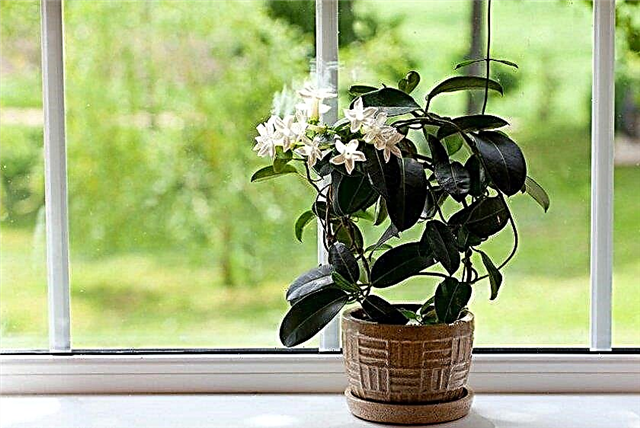
- locationeliminating drafts and differences in day and night temperatures. It is not recommended to leave the liana for the night at the open window or to take it out onto the street. Also, do not leave exotics near a heating source in winter and an air conditioner in summer. At the same time, flower growers celebrate the plant's love for fresh air. The depressed state can be caused by atmospheric pollution, placement in the kitchen, and exposure to tobacco smoke. The bush shows how comfortable it is in the conditions provided;

- temperature, which remains stably warm in the summer and cool, without decline in the winter. Decorative qualities are more pronounced in the range + 18 ... + 23 ° С. Heat exceeding these indicators will lead to overheating of the soil and the plant itself, which will be detrimental. Especially the plant needs thermal adjustment during the budding period and at the flowering stage. Due to possible differences in day and night temperatures, do not leave the plant on the street. Winter indicators should remain within + 12 ... + 16 ° С, which guarantees the subsequent abundance of color. Lowering will adversely affect decorativeness; excess will lead out of dormancy, canceling flowering;

- air humidity, the average high indicators of which for a resident of the tropics should be maintained at home throughout the entire growing season. Use only warm water for daily spraying of the crown and dusting the leaves. Avoid getting water on flowers and buds. If the room is dry, use a humidifier and other ways to increase humidity, for example, install an open container with water or trays with wet expanded clay, pebbles, moss near the pot. During dormancy in winter, stefanotis does not need spraying.
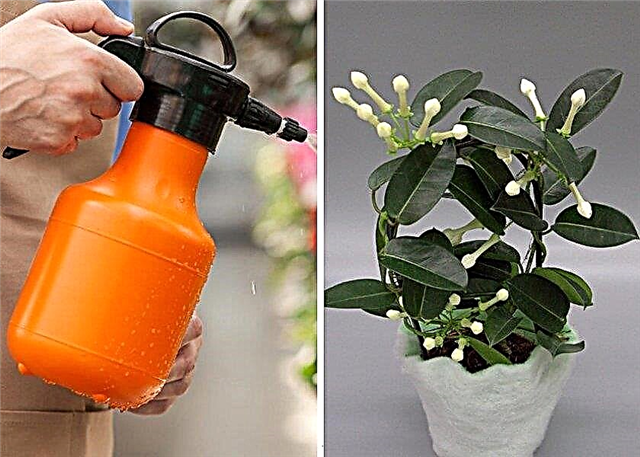
Watering and feeding
The water content in the soil required by Madagascar jasmine varies during periods of active growth and dormancy.
Important! Regardless of the developmental phase of stefanotis, even slight temperature changes plunge the plant into stress and can lead to death.
Subject to the following rules, the bay and drying out do not threaten the flower:
- From March to the end of flowering, water the plant abundantly and regularly 2 times a week, completely soak the earthen lump. Increase the frequency of watering up to 3 times in hot weather.
- Use only soft water at room temperature for irrigation - river, rain, melt, filtered and bottled are suitable. It is permissible to bathe small specimens in the heat (+ 21 ° С and above) under a warm shower (up to + 40 ° С), covering the ground with a bag from erosion, you can leave stefanotis in the bathroom for 30 minutes. after swimming. For large plants, stifling is not suitable because of the size, limit yourself to wiping the leaves with a damp sponge.
- Settle tap water for at least 3 days. The high content of chlorine and calcium salts leads to pathogenic damage to the liana by chlorosis and alkalization of the soil. Not more than 1 time per month, add 5 drops of lemon juice, 1 tbsp. l 9% cider vinegar or crystals of citric acid on the tip of a knife in 1 liter of water for irrigation to maintain the level of acidity in the soil.
- Focus on the condition of the soil. Do not swamp it. Excess fluid must be drained from the pan after 5 minutes. after watering.
- Between water procedures, the top layer of the substrate should dry out by 2-3 cm, but not completely dry.
- With a decrease in temperature, reduce irrigation to 1 time per week, then reduce the volume of water, but not the regularity of its application. In winter, it is necessary to maintain stable soil moisture only in the lower half of the pot, let the upper layer dry at half the depth between irrigation procedures.
- At the first sign that the plant has started to grow, resume constant watering.
Video: Jasmine Care Rules
A guest from the tropics does not need frequent feeding, they will be needed for long-term cultivation in impoverished land without transplants. Unlike many indoor plants, stefanotis prefers long-acting complex mineral-organic fertilizers, which can be replaced by alternating the application of organic and mineral substances.
Did you know? Madagascar jasmine is usually presented as a gift to unmarried girls. According to the beliefs of many nationalities, he attracts suitors and accelerates marriage.
To minimize inadvertent harm from overfeeding and not to burn the roots, listen to the recommendations of experienced gardeners:
- Feeding should be done every 2 weeks with the start of the growing season, while the concentration should be half as much as indicated in the instructions in the year of transplantation and in full dose the next year after it.
- Without good preliminary moistening of the earth (2 hours before feeding), there is a risk of burning the roots, in addition, from the same motives, the recommended dose should be diluted in half.
- Choose fertilizers for flowering plants, where the proportion of potassium and phosphorus needed for abundant flowering is higher than the nitrogen content.
- When laying buds (April - May), use ready-made water-soluble or granular ones with an NPK formula of 0:10:10, for example, AVA, Agrecol, Fertika Lux, and Agricola for Blooming.
- The use of natural organic highly diluted solutions of humus, slurry, bird droppings in a low concentration (1:20) has a beneficial effect on the vine.
- With a decrease in daylight in August, reduce feeding and completely stop in October.
- With active February growth, if transplantation is not planned, resume feeding according to the specified scheme.

Rest period
From mid-November, the bush begins to rest, during which it is necessary to ensure a cool and dry dormant period, which will contribute to laying the abundance of flowers in the future.
Important! Do not use leaf polishes in winter — the film that covers the leaf clogs the pores, which will cause developmental disruption and the release of greenery.
Care is simplified:
- There is no need to maintain high humidity.
- Very accurate irrigation without waterlogging is carried out.
- Spray with warm water (+ 30 ° C) very rarely - only 1 time per month, and you need to forget about feeding for the whole winter.
- At this time, the temperature is + 14 ... + 16 ° C, lowering to + 13 ° C can become critical, because the plant is thermophilic.
- The minimum illumination time of a plant in winter is 12-14 hours. Since this plant is a long daylight, in winter it needs compensating illumination with fluorescent lamps (30W power) on both sides of stephanotis or phytolamps installed at a distance of 25 cm from it.

Pruning
Since Madagascar jasmine quickly stretches up to 3 m in length and blooms on new shoots, pruning it needs. In early spring, before the beginning of flowering, a moderate sanitary cleaning is carried out with a weak development, elongated and exposed state of old and sick lashes or their thickening.
In summer, it is worth pinching the shoots to increase the flowering time. But the best time to prune it is to end flowering. To maintain a compact shape and enhance branching, cut long shoots by a third. Removing sluggish inflorescences contributes to the emergence of new ones and the formation of an attractive crown. Avoid radical haircuts, try to maintain the bulk of the lashes.

Reasons for falling and yellowing leaves
If you are concerned about the autumn leaf fall of yellow leaves of an evergreen liana, you should know that the loss of strong leaves in the fall and winter reaches 50%. By yellowing, stefanotis reacts to a reduction in daylight hours; in spring, young buds develop in place of old sinuses. This phenomenon can be observed after transplantation, the plant sheds excess after stress.
Important! When filled, the leaves grow dull, droop, but do not fall. It is worth checking the roots, removing the rotten ones and replanting the bush in dry soil.
Prolonged mass decline should alert and force to find out the reason for eliminating the deficiencies in care that provoke the discharge of leaves, including:
- drafts;
- lack of lighting;
- irrigation with lime water;
- lack of moisture;
- overheating or hypothermia;
- low humidity.

How to propagate jasmine
Stefanotis is propagated in a vegetative way using stem cuttings and sowing seeds. The best seasons for its breeding are spring and summer.
Seeds
At home, it is difficult to implement, since the fruits do not ripen to the end. Ordering seeds is also not worth it - they do not withstand long transportation and do not give germination. But if your plant has successfully passed all stages of development and brought a ripe fruit with seeds, you can have patience for trying to get seedlings.
Did you know? Jasmine tea is made from fragrant sambac flowers, a similar variety of indoor jasmines.
For this:
- Freshly harvested seeds leave to dry for 2 days.
- Then soak them in warm water for 2 days, adding a few grains of "Epina" and potassium permanganate.
- Prepare and sterilize the soil for seedlings - mix peat with perlite or sand in equal parts, steam or microwave for 1-2 minutes, transfer to a container for seedlings.
- Lay out the seeds by squeezing a little into the ground.
- To create greenhouse conditions with a perfectly humid microclimate without air circulation, cover future seedlings with glass, transparent plastic or place in a transparent bag.
- Place the seedlings in a warm, bright place (+ 22 ... + 25 ° C) without direct sunlight.
- Remove cover periodically for ventilation and moisture, wipe accumulated condensation on the lid.
- After 3-4 weeks, the first sprouts will appear, after which the container can be left without shelter.
- When the first pair of leaf blades appears, seedlings of 2–3 pcs. into small pots with a soil mixture for an adult plant.
- Feed the plants after 2 weeks with a weak solution of nitrogen fertilizers, so you get a lush green mass.
- With a daylight duration of less than 14 hours, young bushes will have to be illuminated.

Cuttings
The reliability of the vegetative method of reproduction is tempting with simplicity.
Important! Bottom heating of an impromptu greenhouse will increase the chance of rooting.
You can do this this way:
- Cut the apical cuttings of last year's branches up to 10 cm long at an angle or use half-lignified after trimming, with 1-2 internodes.
- Leave one pair of top leaves, remove the bottom, dip in a root stimulator.
- To speed up the process, cut off the upper half of the sheet, sprinkling the cuts with charcoal.
- Prepare a loose, moist soil from a part of a standard earth mixture for a plant, into which an equal part of sand or perlite must be added. Place the stalk at an angle, digging it to a depth of 1.5 cm.
- Create a hotbed and place in a warm place (+ 25 ... + 30 ° C) with plenty of ambient light, ventilate the cuttings daily and maintain humidity.
- For 1.5 months. rooting will occur, as reported by the appearance of new greenery on the shoot.
- Plant them in a permanent place in the soil for an adult plant and form as they grow. When reaching 50 cm, cut the branches by a third for branching.

Diseases and pests of stefanotis
Features of a tropical creeper require strict adherence to the rules for caring for it, and any violation leads to negative consequences, weakens the immune system and puts the risk of infection. Stefanotis is most affected in the fall and winter, when the difference in humidity and temperature is too dangerous.
Did you know? Plants are able to arithmetically accurately calculate the dose of food needed before the next dawn, which is extracted from carbon dioxide using solar energy.
Common problems are:
- root rot and powdery mildewwith which the liana is affected due to stagnation of water and dampness. Change the conditions of detention, ensuring complete replacement of the substrate, removing rotten parts and diseased leaves, and treat fungal infections with a fungicide, for example, a solution of Fundazole (2 g per 1 liter of water), Homa or one of the preparations Skor, Topaz "," Previkur "according to the instructions. With minor damage, triple spraying with a weak solution of potassium permanganate is sufficient with a break of 5 days;
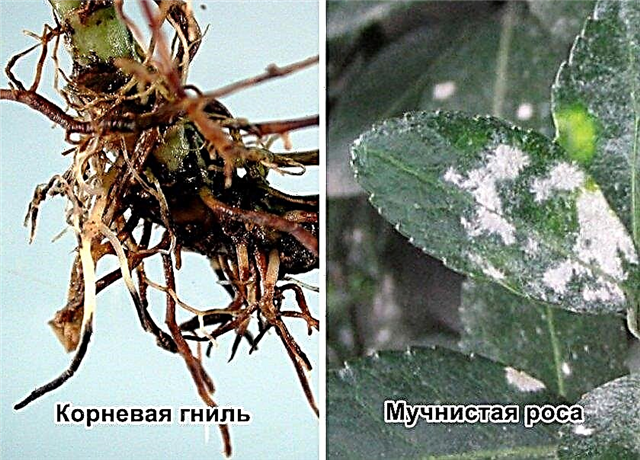
- shields, aphid, mealybug, sciarid larvae and spider mitewhich, if detected untimely, can have time to completely destroy stefanotis, therefore, bypassing experiments with folk remedies, immediately proceed to strong insecticides and acaricides, such as Aktara, Aktellik or Fitoverm. A single treatment is not enough to destroy the next generation. Spray 1 time per week until insects or mites completely disappear. Regularly monitor the condition of the plant.

Beautifully blooming liana will not leave anyone indifferent. And if you are ready to constantly take care of an exotic miracle in your own home, then dreams of flower garlands will come true in the first year of owning luxurious Madagascar jasmine.







